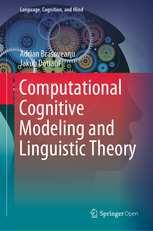Book is out and OPEN ACCESS
Fri 15 May 2020 by Adrian BrasoveanuThe book Computational Cognitive Modeling and Linguistic Theory (Springer, Language, Cognition, and Mind (LCAM) series, Vol. 6) with Jakub Dotlačil is finally out and OPEN ACCESS here.

The two blurbs below are also available on the Springer page for the book:
This open access book introduces a general framework that allows natural language researchers to enhance existing competence theories with fully specified performance and processing components. Gradually developing increasingly complex and cognitively realistic competence-performance models, it provides running code for these models and shows how to fit them to real-time experimental data. This computational cognitive modeling approach opens up exciting new directions for research in formal semantics, and linguistics more generally, and offers new ways of (re)connecting semantics and the broader field of cognitive science.
The approach of this book is novel in more ways than one. Assuming the mental architecture and procedural modalities of Anderson’s ACT-R framework, it presents fine-grained computational models of human language processing tasks which make detailed quantitative predictions that can be checked against the results of self-paced reading and other psycho-linguistic experiments. All models are presented as computer programs that readers can run on their own computer and on inputs of their choice, thereby learning to design, program and run their own models. But even for readers who won’t do all that, the book will show how such detailed, quantitatively predicting modeling of linguistic processes is possible. A methodological breakthrough and a must for anyone concerned about the future of linguistics! (Hans Kamp)
This book constitutes a major step forward in linguistics and psycholinguistics. It constitutes a unique synthesis of several different research traditions: computational models of psycholinguistic processes, and formal models of semantics and discourse processing. The work also introduces a sophisticated python-based software environment for modeling linguistic processes. This book has the potential to revolutionize not only formal models of linguistics, but also models of language processing more generally. (Shravan Vasishth)
Summary:
The book integrates formal semantic theories, specifically, DRT, and mechanistic processing models formulated in the ACT-R cognitive architecture into a new computational framework that can simulate human participants in real-time psycholinguistic tasks, fit these cognitive models to experimental data by embedding them into Bayesian models, and quantitatively compare qualitative (symbolic) theories.
In more detail, we introduce an extensible framework for mechanistic processing models that integrate formal syntax and semantics theories, an independently motivated cognitive architecture (ACT-R; Anderson and Lebiere 1998, Anderson 2007) and Bayesian methods of data analysis, parameter estimation and model comparison. The book culminates with the development of computationally-explicit processing models for natural language semantic phenomena that integrate Discourse Representation Theory (DRT; Kamp 1981, Kamp & Reyle 1993), ACT-R and Bayesian models.
These mechanistic processing models implement end-to-end simulations of human participants in real-time psycholinguistic experiments. End-to-end means that we model visual and motor processes together with specifically linguistic representations and processes in complete models of the experimental tasks. The models embed theoretical hypotheses about linguistic representations and about parsing processes in ACT-R. The resulting ACT-R cognitive models are then embedded in Bayesian models to fit them to experimental data, estimate their parameters and perform quantitative model comparison for qualitative (symbolic) theories.
A novel Python3 reimplementation of ACT-R called pyactr (current version; book version, including all book code) provides the crucial software infrastructure for developing ACT-R models that can be easily embedded in Bayesian models.